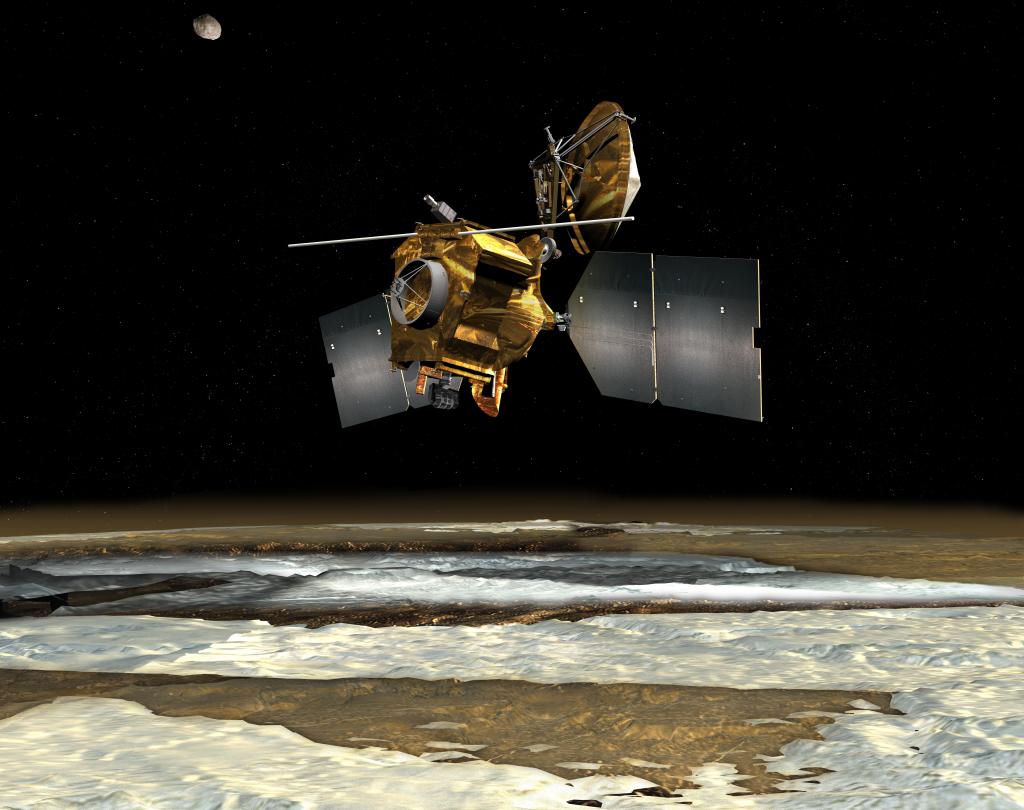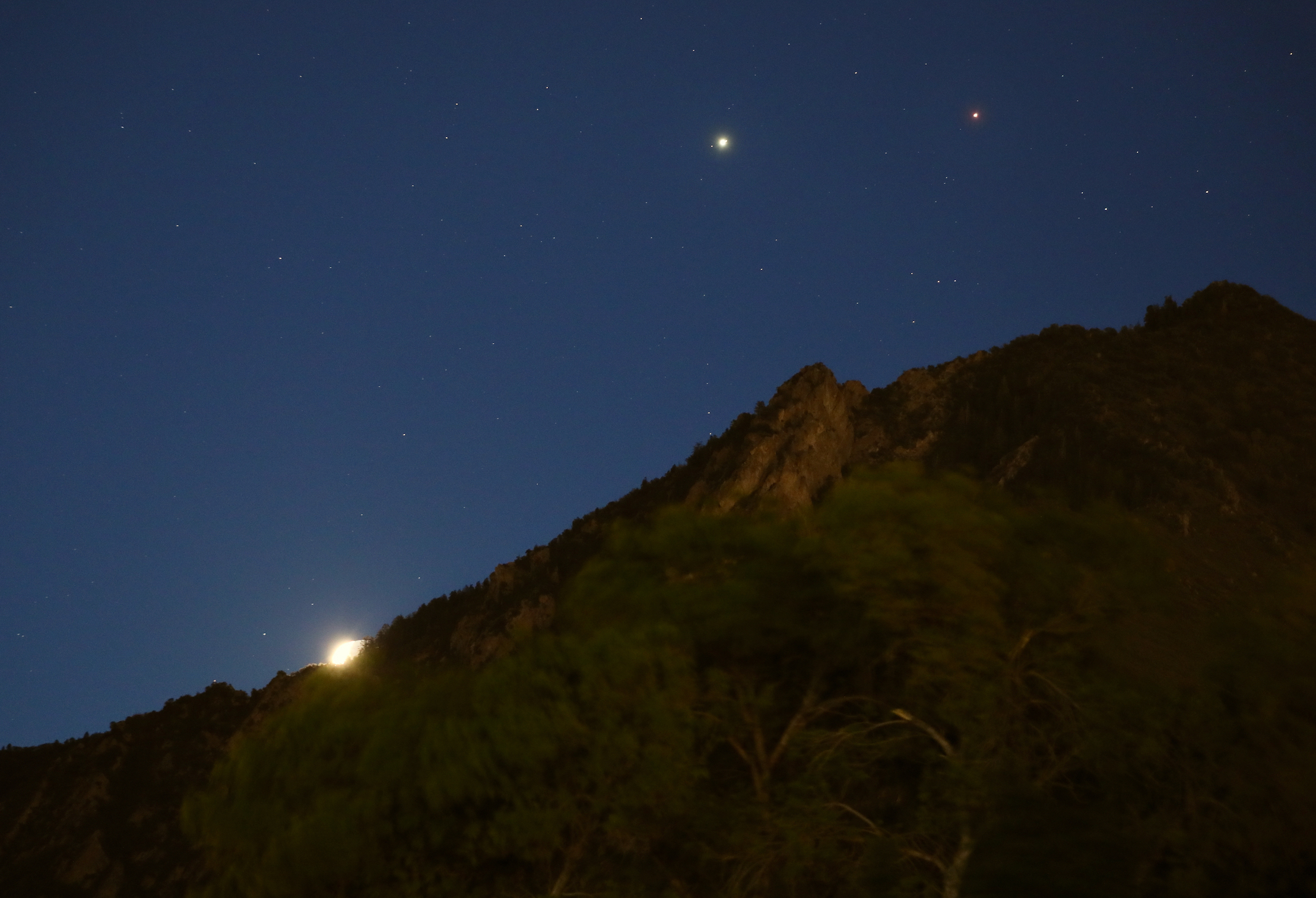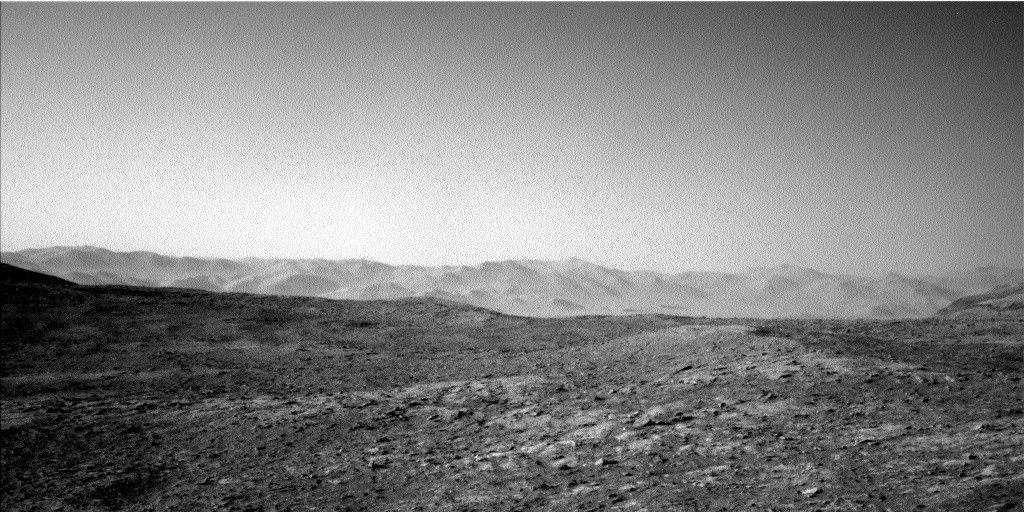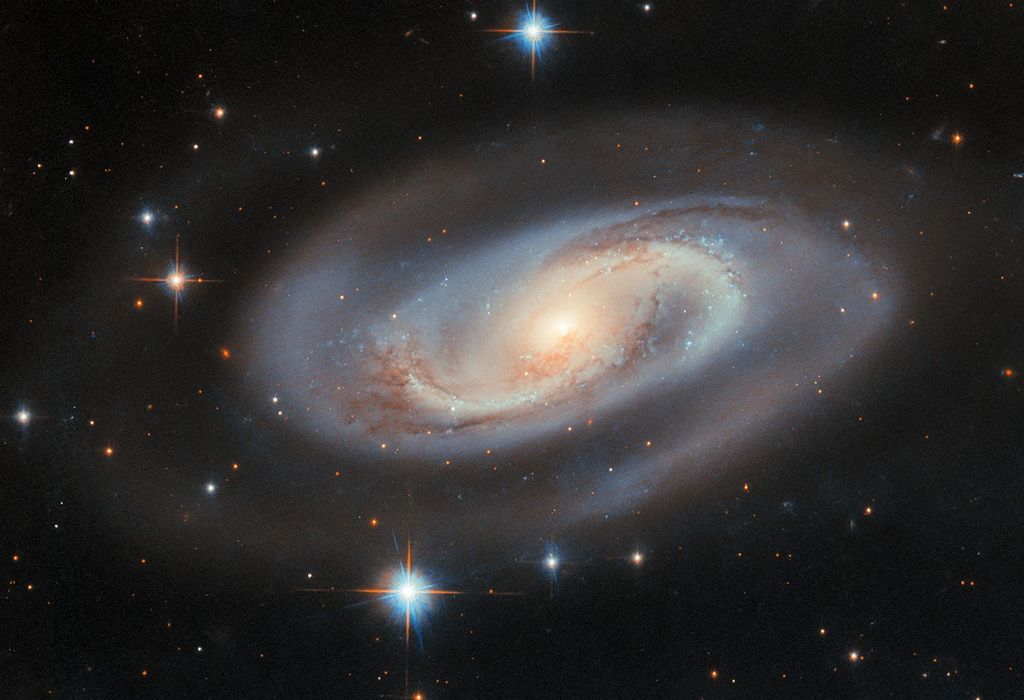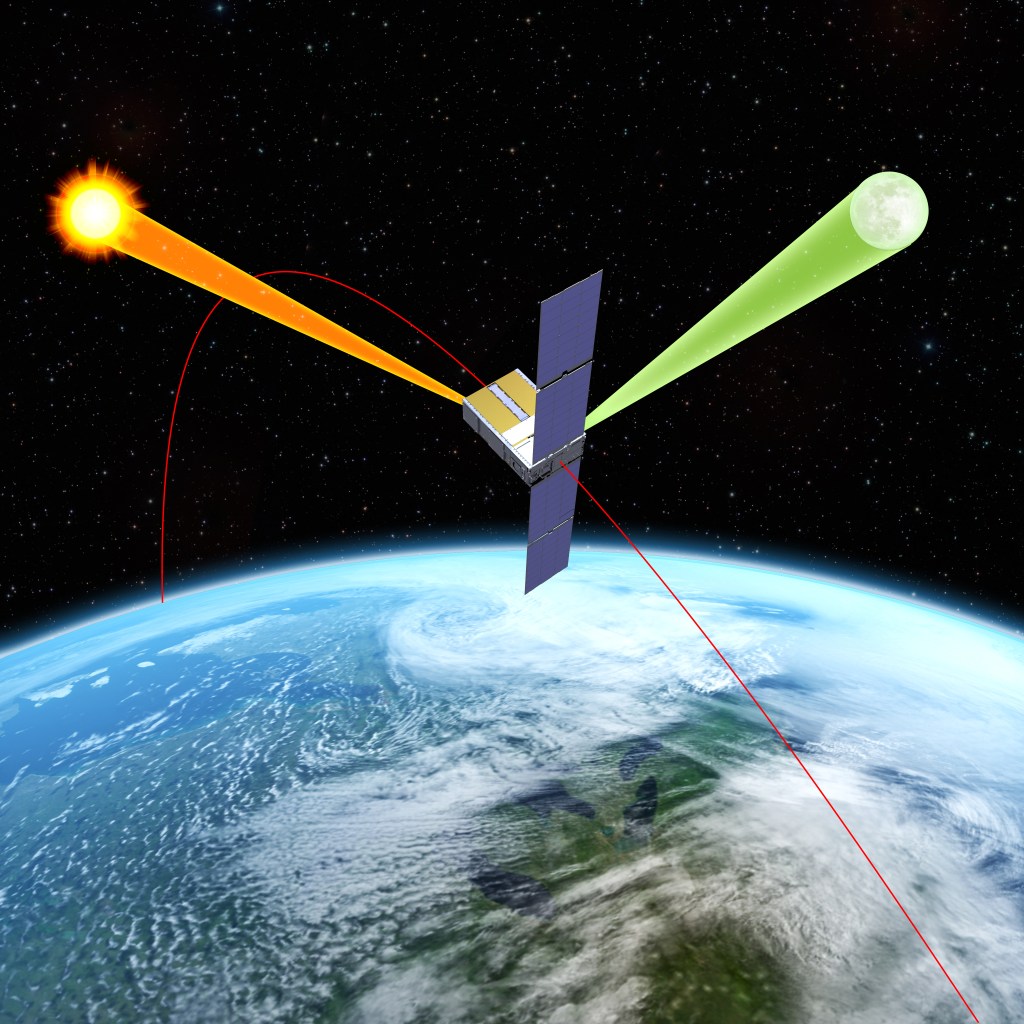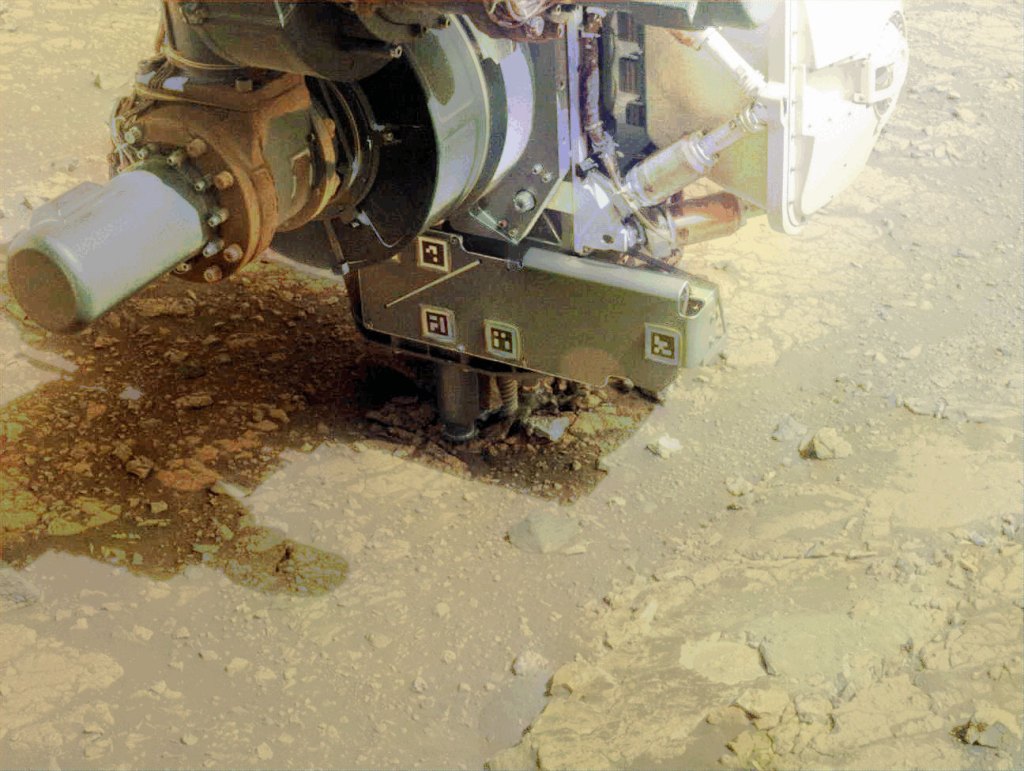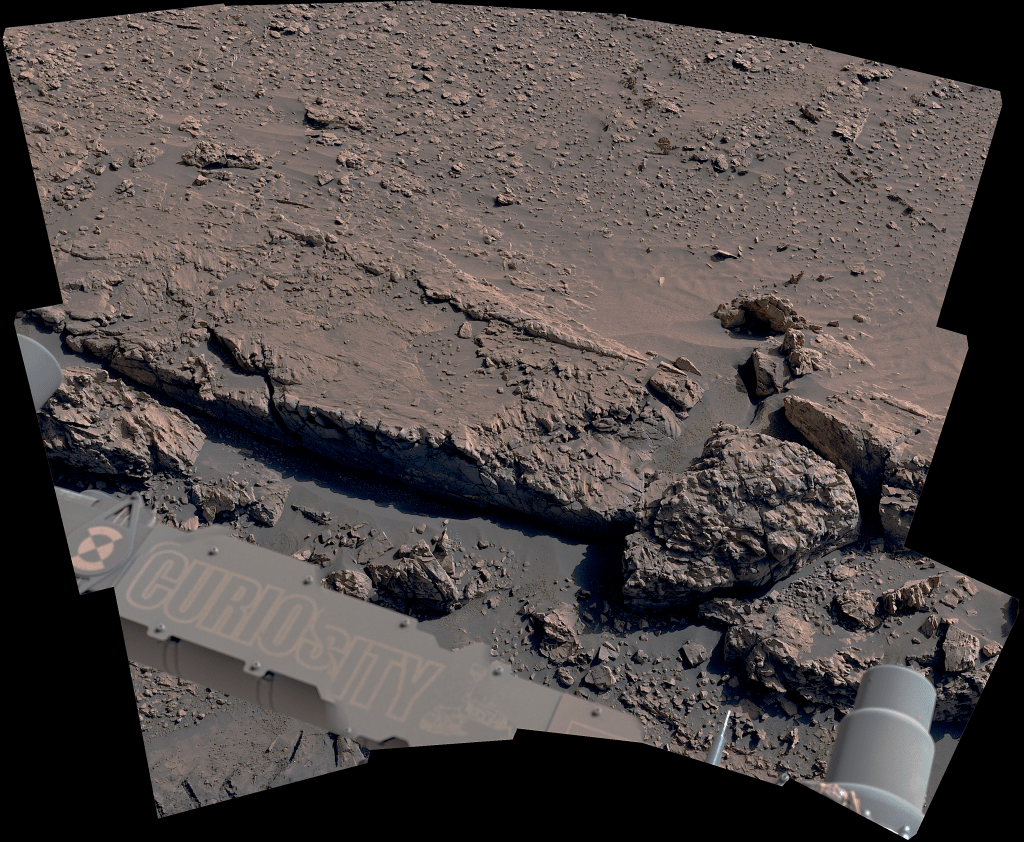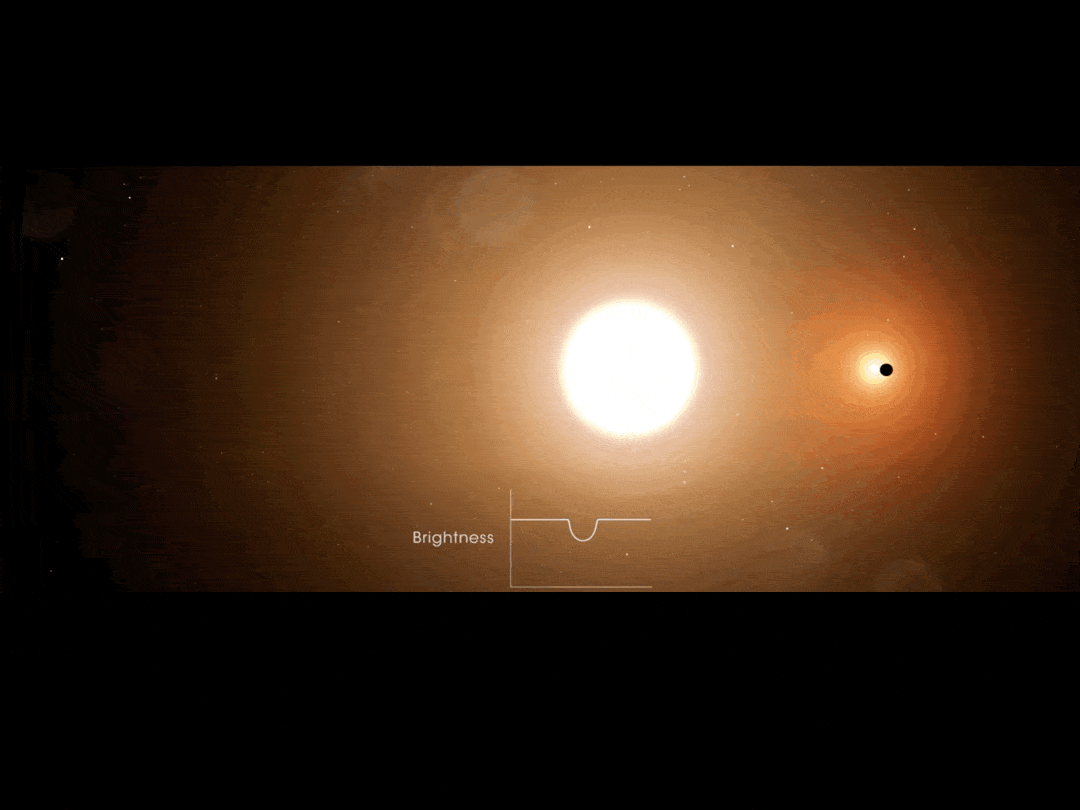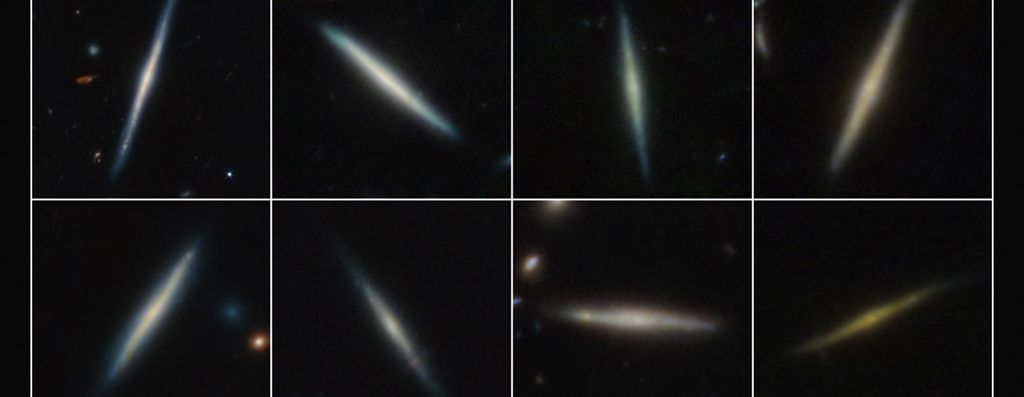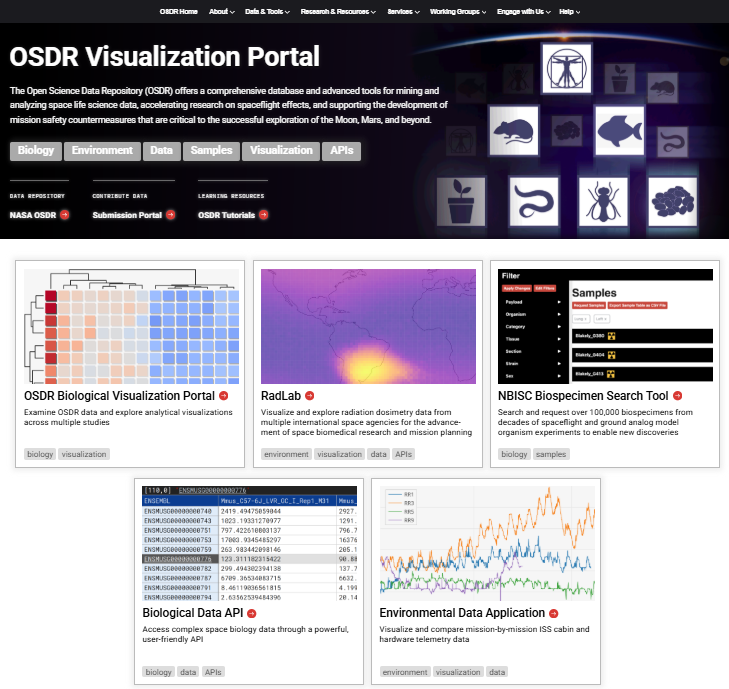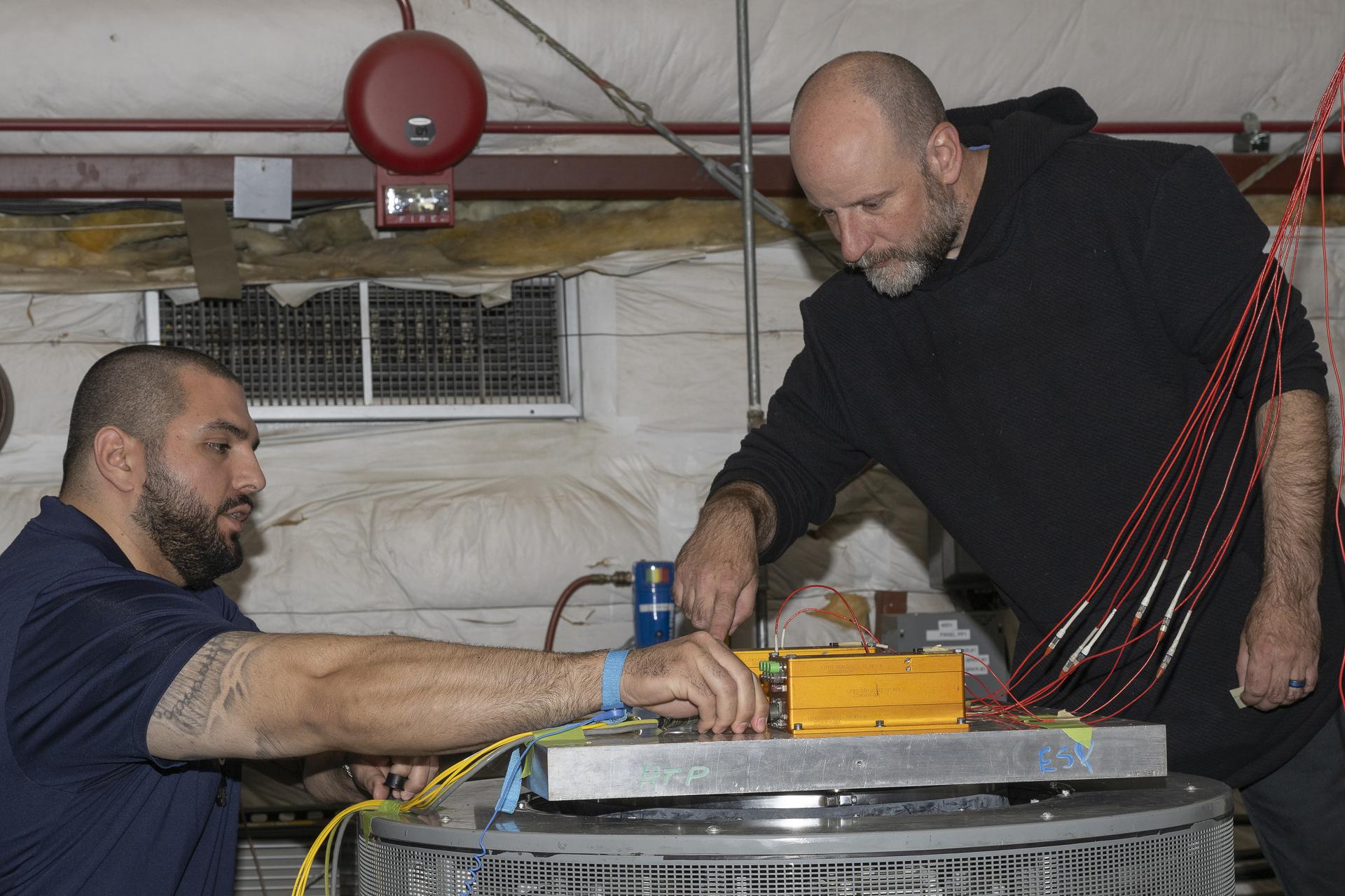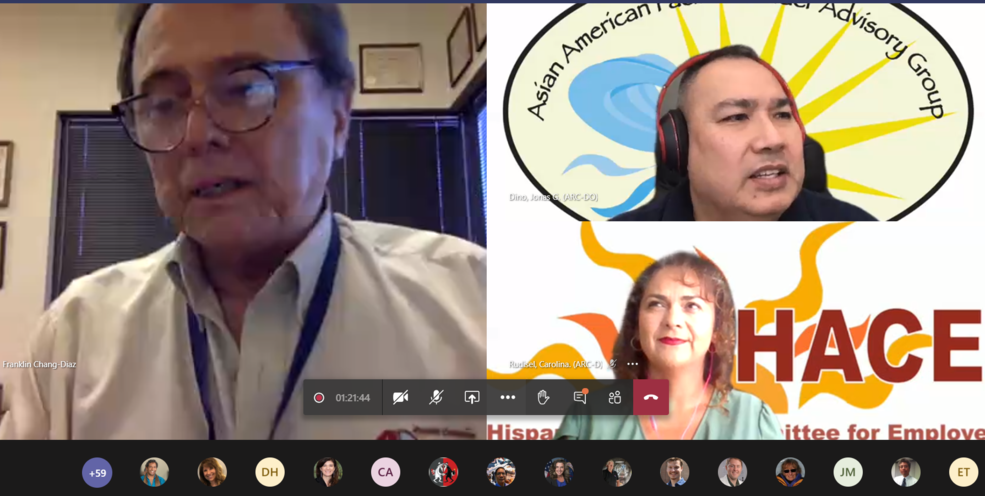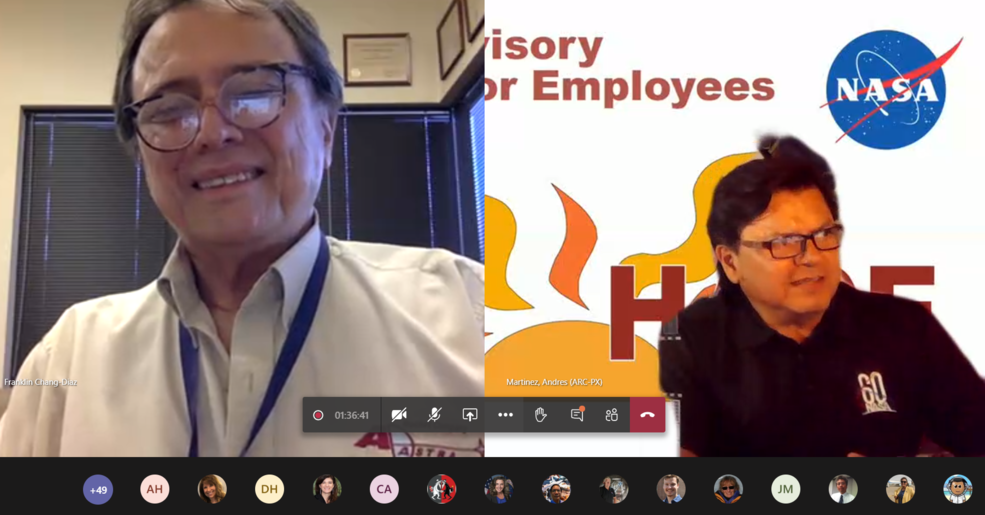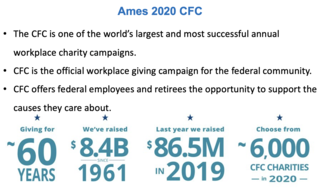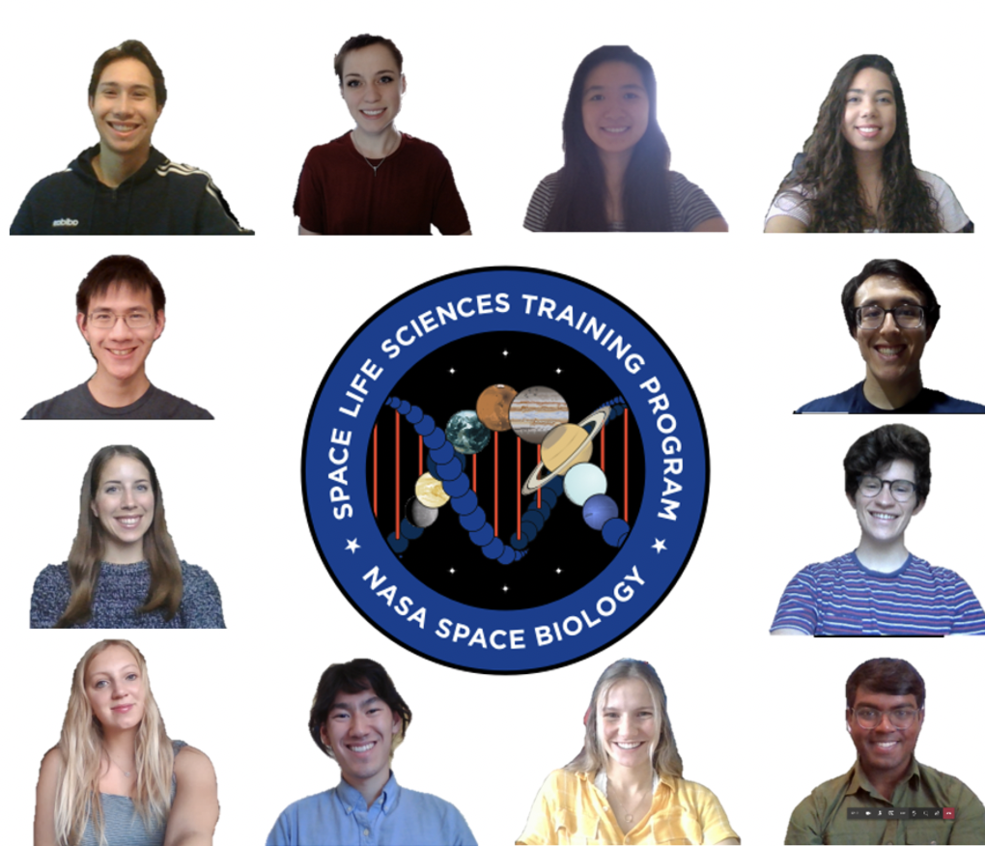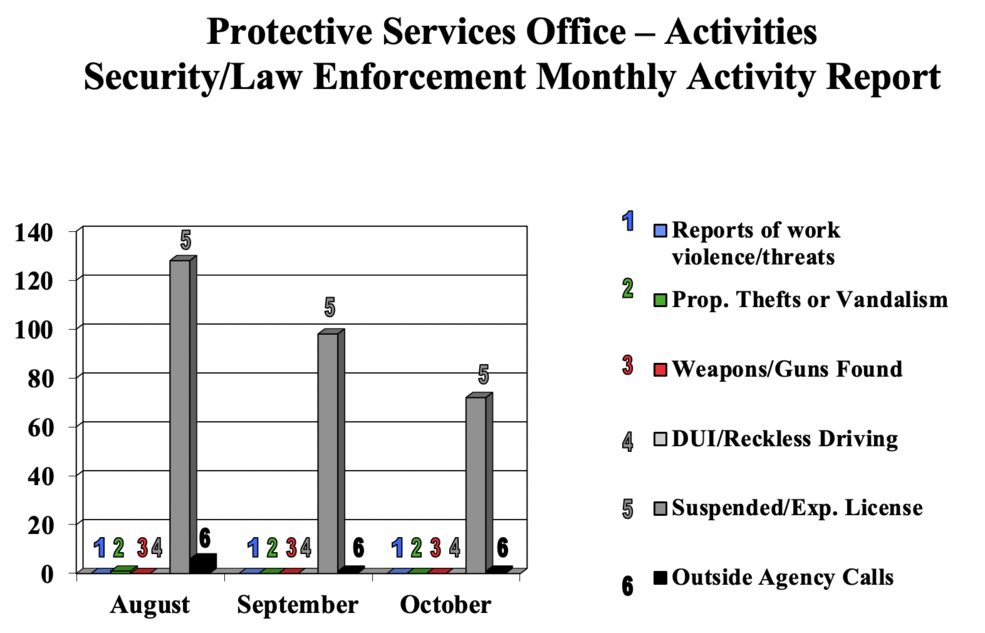November 2020 issue of Ames' newsletter, the Astrogram
Simulating NASA’s Rocket Launch for Artemis Moon Missions
by Frank Tavares
As part of the Artemis program, NASA is preparing to test the integrated systems that will take crew on missions to the Moon, including a powerful new rocket that will launch crew and cargo to lunar orbit. There are many critical moments in a rocket’s journey from the ground to orbit, but perhaps none more so than the moment of ignition from the launch pad. When the Space Launch System, or SLS, rocket engines begin to roar – emitting fire, smoke, and shockwaves – it is critical the entire launch complex is designed to withstand the pressure.
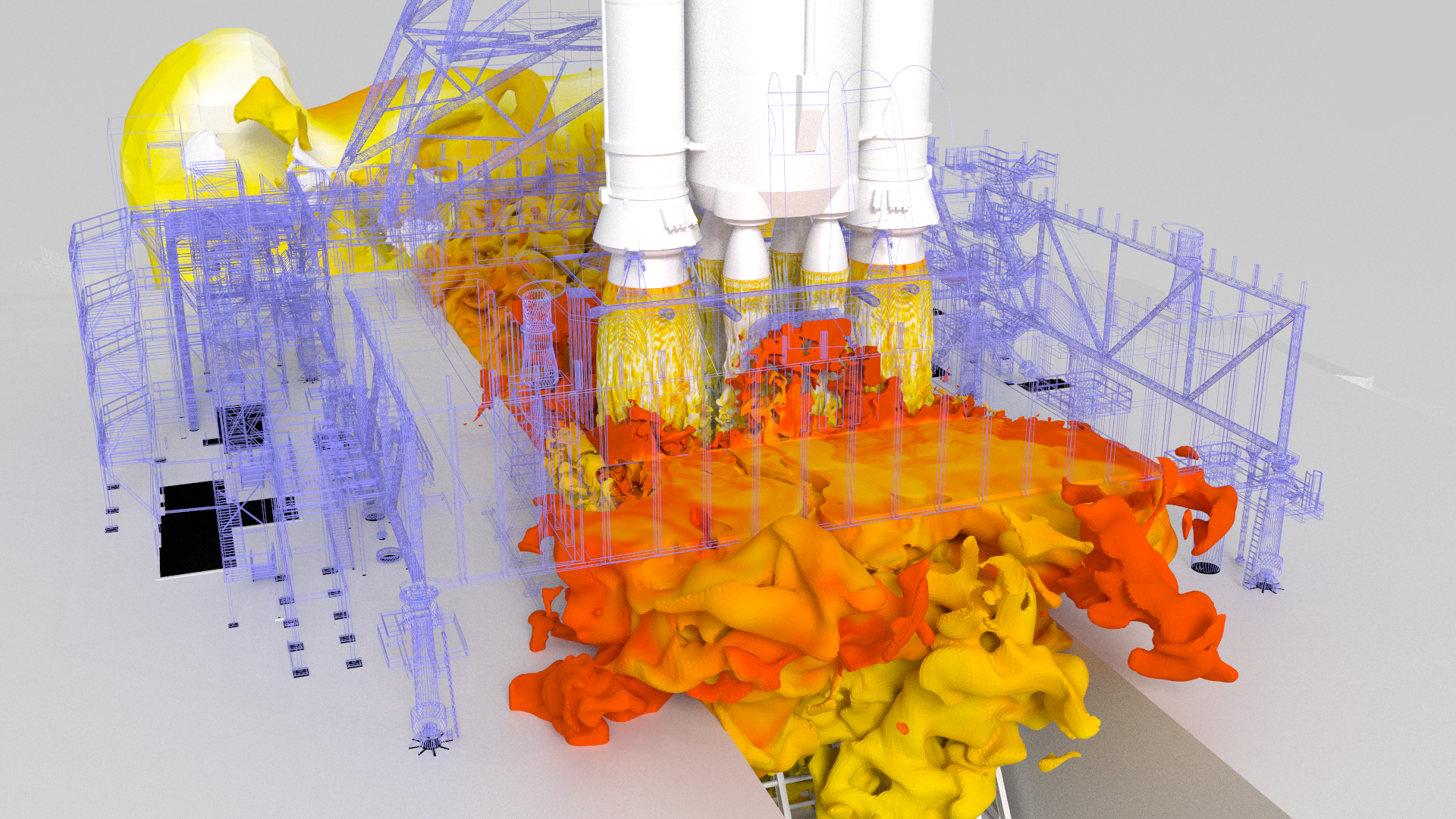
The image above shows a visualization of the exhaust gas flow of SLS taking off from Launch Complex 39B at NASA’s Kennedy Space Center in Florida for the Artemis I mission. Plume contours are colored by temperature. White is high temperature, while red is cooler. Purple outlines highlight the geometric complexity included in the launch pad simulation.
The Launch Ascent and Vehicle Aerodynamics, or LAVA, team at NASA Ames, uses these simulations to accurately understand how liquid and gases flowing during launch can cause various kinds of waves.
The first waves are created when a rocket engine rapidly ignites. This generates a short series of overpressure waves. After that, the turbulent plumes of exhaust generate longer-duration acoustic noise that persists as the spacecraft ascends.
Both the overpressure and acoustic pressure waves travel directly up through the mobile launcher’s exhaust hole and through the flame trench below the mobile launcher. Once the pressure waves have cleared the mobile launcher, they continue moving up and alongside the rocket towards its payload – putting both at risk.
To counter these overpressure and acoustic pressure waves, a water-based suppression system dumps more than 400,000 gallons of water per minute onto key locations at the launch site. This is needed to protect the Orion spacecraft and its crew and payloads from the powerful pressure waves created during launch atop SLS. It also creates an extremely complex and dynamic environment.
To replicate a launch environment digitally, the rocket as well as the gas, liquid, and shockwaves it creates and the water dumped through suppression systems must also be simulated. LAVA can accurately test out all these systems virtually to help ensure when launch day arrives, everything goes smoothly.
Legacy of Space Station Biology Samples Stored in Unique Archive
by Gianine Figliozzi
A unique collection is tucked away in a biospecimen storage facility at NASA Ames. It’s the world’s largest repository of non-human space biology samples from previous NASA-supported research studies. The archive houses specimens predominantly from rodent studies, but it also includes quail tissues and samples of microbes.
Tissue samples, and even mouse droppings recovered from habitats flown on the International Space Station, have been instrumental in helping researchers gain insights into the effects of spaceflight on living systems.
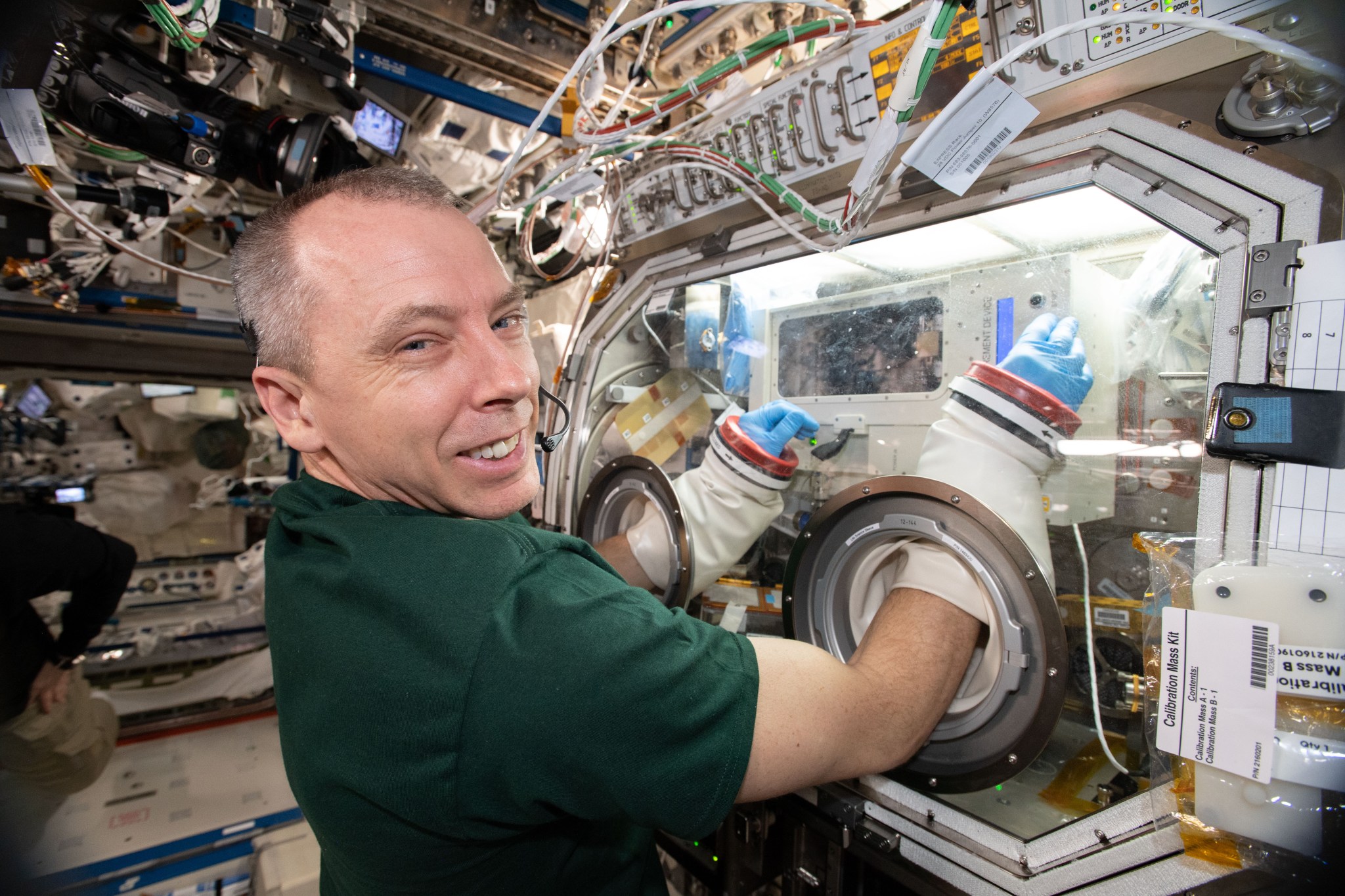
As the space station celebrates 20 years of continuous human presence in low-Earth orbit on Nov. 2, the NASA Institutional Scientific Collection at Ames, managed by the center’s Life Sciences Data Archive, holds onto a legacy of experiments that have made this 250-mile-high orbiting laboratory invaluable to science. The future of space biology research – advancing our understanding of the effects of space radiation, microgravity, and more on biological systems – is also contained in this treasure chest which consists of many test tubes and vials within the archive that are available for additional scientific study.
“The collection is a gold mine of samples which contain clues to life sciences discoveries which can further enable spaceflight,” said Ryan Scott, project scientist for the Ames Life Sciences Data Archive. “It’s the largest of its kind, and only a handful of such repositories exist anywhere on Earth.”
Back to the Future
NASA provides an opportunity to generate new scientific knowledge from previously flown spaceflight experiments by sharing these biospecimens with the scientific community through an open-science approach.
Dating back to 1979, the collection stores about 32,000 animal and microbial biospecimens. Although mostly obtained from space station and space shuttle flight investigations, the collection also includes samples brought back to Earth from Russian Cosmos flights. In addition, it houses samples from spaceflight analog studies that approximated certain conditions of spaceflight in ground-based laboratories.
How Extreme is Spaceflight?
For 20 years, humans have continuously lived and worked in space aboard the space station. This achievement has its roots in more than a half-century of NASA’s experience with human space exploration and space biology research that studies how life responds to the extreme conditions of living in space.
All terrestrial organisms – from tiny plankton to towering redwoods, and whether they swim, soar, walk, wriggle, or exist permanently attached to rocks – have adapted to Earth’s constant force of gravity. They adjust to a regular cadence of daily and seasonal cycles of light and darkness. They live surrounded by Earth’s atmosphere and magnetosphere, dual protective shields that block most of the forms of high-energy space radiation from reaching the surface.

Spaceflight produces significant changes in physics and biology which affect living systems, namely responding to alterations in gravity and radiation exposure. NASA seeks to learn as much as possible about these changes and more, to better understand the risks of spaceflight to astronauts. The results from this research are applied toward mitigating the effects of spaceflight during future long-duration human missions to the Moon as part of the agency’s Artemis program and further on to Mars.
The orbiting laboratory’s unique research capabilities have helped reveal basic biological changes that occur in living things in space. NASA’s research includes long-duration studies of organisms, such as rodents, that have body systems similar to humans and can model human responses to spaceflight.
“The International Space Station’s research platform has been absolutely essential in providing scientists with the biospecimens necessary to discover how mammalian life is affected in low-Earth-orbit,” said Ryan.
Recent examples of discoveries made using the archived biospecimens include recognizing changes in the gut microbiome that suggest a shift in microbial and host metabolism during spaceflight; a cellular mechanism by which microgravity induces pelvic bone loss; and the effects of spaceflight on the eye and corresponding molecular responses.
The collection of biospecimens at Ames has been analyzed by researchers using a wide range of techniques, including microscopy, histology – an examination of the structure of tissues – and a number of molecular analyses collectively known as “omics.” Omics analyses examine different types of biomolecules, such as DNA, RNA, and proteins.
NASA’s GeneLab, the first comprehensive space-related omics database, has processed biospecimens from the NASA Institutional Scientific Collection at Ames. GeneLab’s omics data are available to researchers through their open-science data system for bioinformatics and systems biology analyses.
“There is still a great deal of science yet to be done in addressing the molecular, physiological, and overall health effects of spaceflight, in addition to developing effective countermeasures,” said Sylvain Costes, project manager of GeneLab at Ames. “The untapped opportunity to get involved in space biological research, either through requesting specimens from the collection, or analyzing omics data though GeneLab, is open to the worldwide community.”
Hispanic Heritage Month Special Session with Dr. Franklin Chang Diaz, Former NASA Astronaut
On Oct. 6, in recognition of Hispanic Heritage Month, the Hispanic Advisory Committee for Employees, or HACE, and the Asian American and Pacific Islander Advisory Group, or AAPIAG, hosted a special session with Dr. Franklin Chang Díaz, former NASA Astronaut and CEO of Ad Astra Rocket Company. Dr. Eugene Tu, Ames Center Director, welcomed participants and introduced the guest speaker. He highlighted Díaz’ exceptional career as an astronaut, CEO, author, inventor, and referenced Díaz’ book, Dream’s Journey, citing his humble journey from a bank teller in Costa Rica to an astronaut.
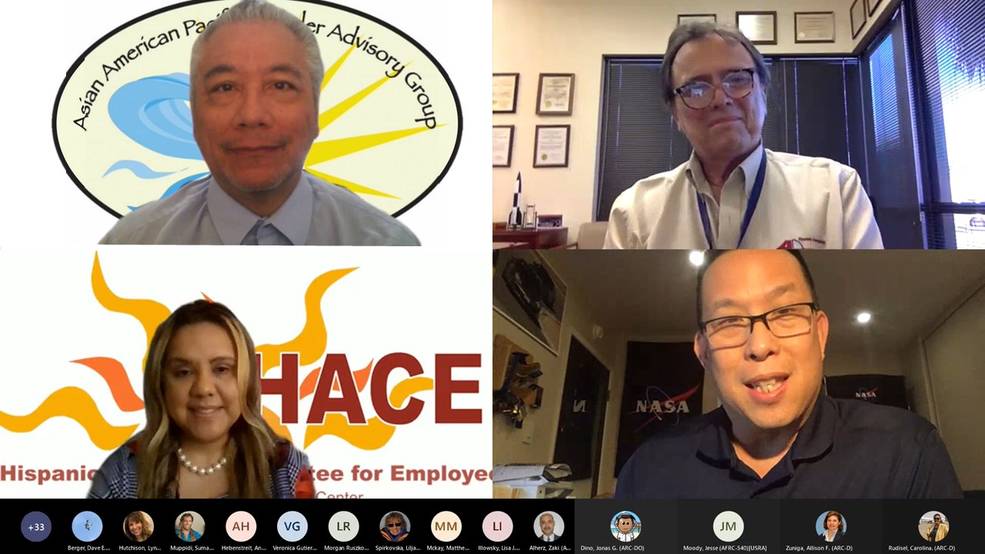
During the session, Díaz highlighted his childhood during the early stages of the space age and how the first astronauts and cosmonauts were childhood heroes. After saving $50 and receiving a one-way ticket from his father, he set about realizing his dreams and immigrated to the United States. He spoke about having to return to high school where he learned English and was able to prove himself, graduating near the top of his class. Citing the generosity from many people, “no one gets anywhere without someone else’s help,” he received a one-year scholarship from the state of Connecticut which was enough to start his long string of academic accomplishments. In 1977, he became a proud citizen of the United States.
Persistence, preparation, and hard work were key themes for Diaz’ talk. After being rejected on his first application to the astronaut core, he persisted and applied two years later. The second application was successful; he was interviewed and sent home. A few months later, Díaz received the incredible job offer. Once in the astronaut core, he made history. Díaz was NASA’s first Hispanic astronaut and went on to tie the world record for missions flown – seven shuttle missions in total spanning more than 1,600 hours. After leaving NASA, he pursued his passion for space by starting his own company, Ad Astra Rocket Company, which is developing a magnetoplasma rocket.
Throughout the entire session, Díaz inspired others with his words of wisdom, funny anecdotes, and views on the value of diversity in exploration.
View the session with Dr. Franklin Chang Diaz at: https://youtu.be/p8FG0pJAD3Y.
The Ames 2020 CFC, We Give Because We Care – Let’s Show Some Love, Ames!
by Harry Jackson, Ames CFC Campaign Manager
It’s time to Show Some Love! This year’s Combined Federal Campaign, or CFC, is in full swing and will run through Jan. 15, 2021. You’re invited to join the hundreds of thousands in the federal community who pledge through the CFC year after year.
Not sure what the CFC is or how it works? On March 23, 1982, President Reagan issued executive order 12353 “Charitable Fundraising,” which created the modern CFC. One of the largest and most successful employee fundraising campaigns in the world, the CFC is the official workplace giving opportunity for the federal government. The mission of the campaign is to promote and support philanthropy through a program that is employee-focused, cost-efficient, and effective in providing federal employees the opportunity to improve the quality of life for all.
The CFC allows federal employees, contractors, and retirees to combine efforts to raise money, volunteer, and “Show Some Love” to their favorite CFC-supported charities.
Ames is a leader among Bay Area federal agencies in generosity and support of the CFC. Ames has been the number one contributor in caring for others for a number of years within the Northern California CFC, covering 40 counties. We believe there is a direct correlation between the success of the campaign and management interest, involvement, and support.
Whether this is your first experience with the CFC or your fifteenth, it’s helpful to know your giving options. You can contribute financially to one or more charities of your choice through payroll deduction, credit card, and e-check. You can even pledge volunteer hours! So, please think about the cause(s) you want to support and how much you can give to help those in need.
Not sure how much to give to your favorite charity? Last year, the average gift in the Northern California CFC Zone was $577.00. Please consider whether you’re able to match or even exceed that amount. However you choose to give, every little bit makes a difference for those in need. Your pledge can be completed anonymously or with the release of your contact information to the charity you are supporting. This year’s fund-raising goal for 2020 is $220,000.
Please visit your Ames CFC Website at: https://cfc.arc.nasa.gov for a list of charities to find those with programs that support your chosen causes or contact your directorate CFC key workers for more information or if you need assistance designating your pledge. Let’s come together Ames and Show Some Love for our CFC charities and those they serve!
Cheers, and thank you for your support,
POC: Harry Jackson, ARC CFC Chief Coordinator
POC: Bryan Biegel, ARC Deputy Chief Coordinator
Applications are Open for the Space Life Sciences Training Program 2021 Virtual Session
NASA Ames’ 2020 Space Life Sciences Training Program, or SLSTP, successfully culminated on Friday, Aug. 14, the first-ever virtual implementation of the popular program normally held in person at NASA Ames over a period of 10-weeks each summer. Ten interns, two staffers, and nine Ames mentors participated in the program funded by Ames’ Space Biology Program. The interns spend 80% of their time on projects with their individual Ames mentors and 20% time on a group project and professional development activities.
Professional development and networking activities are important components of the program and included: coaching on public speaking, proposal writing tips, and small interactive meetings with Space Biology and other NASA directors, Astronauts Steve Smith and Zena Cardman and notable scientists including, John Mather. Normally the interns are able to tour Ames and other NASA or scientific facilities in the area. During the pandemic, the SLSTP team organized virtual tours of the Lick Observatory, Ames Arc Jet, Virtual Motion Simulator, Future Flight Central and the B747-400 Simulator.
For their group project component, SLSTP interns developed a proposal for a piggy-back payload on a 15-day autonomous high-altitude vehicle flight, Swift HALE, scheduled for June 2021. Their project, entitled RadBREAD: Radiation Biology Research at an Elevated Altitude through Dosimetry, will expose multiple yeast strains to the stratospheric environment and correlate biological data with data from an accompanying DLR M-42 dosimeter to be provided by the German Space Center (DL). The interns will continue developing the payload over the course of the upcoming school year, led by SLSTP director and principal investigator, Sigrid Reinsch. Collaborators on RadBREAD include Drs. Sergio Santa Maria (ARC-SCR), Jack Miller (LBL), Thomas Berger (DLR), Sylvain Costes (ARC-SCR), Jonathan Galazka (ARC-SCR), and Matthew Fladeland (ARC-SG).
The major component of the SLSTP internship are individual projects with Ames mentors. During the application process, applicants choose and rank specific projects/mentors, and the final choice of the highest ranked interns is done by the individual mentors. Normally, the majority of the projects are laboratory-based. SLSTP management worked with the mentors during the spring to help pivot the projects to virtual – and 9 of the 10 original projects were able to be converted to virtual projects. To culminate the program, SLSTP held two sessions of formal presentations by the interns of their individual and group projects. Recordings of the final presentations are available to those who were unable to attend.
On the final day of the program, a networking session with SLSTP alumni was held. At least 20 alumni attended the event. Lightning talks were presented by SLSTP alumni Alissa Bandalene (2014), Joshua Tate (2014), Kaixin Cui (2018), Andy Pelos (2017), and Anna-Sophia Boguraev (2018), followed by self-assembled panels grouped by current affiliation (government, academia, and private industry).
The 2021 virtual summer session applications are now open. If you or someone you know would like to know more about the NASA Ames SLSTP, please visit us here: https://www.nasa.gov/ames/research/space-life-sciences-training-program
NASA Simulations Validate Orion Safety Models for Artemis Astronauts
by Frank Tavares
As part of the Artemis program, NASA’s Orion spacecraft will carry the first woman and next man to lunar orbit before they land on the Moon in 2024, and enable sustained presence on and around the Moon by the end of the decade. An integral part of ensuring safe spaceflight is Orion’s Launch Abort System, or LAS, shown here in gray. This state-of-the-art crew escape system is attached to the top of the spacecraft, which sits atop the agency’s powerful Space Launch System rocket. In case of emergency during takeoff, it can quickly separate from the speeding rocket and pull astronauts to safety.
To propel Orion away to safety, the LAS uses an abort motor that produces four large, high-speed exhaust plumes that flow along the sides of Orion, generating extremely strong vibrations.
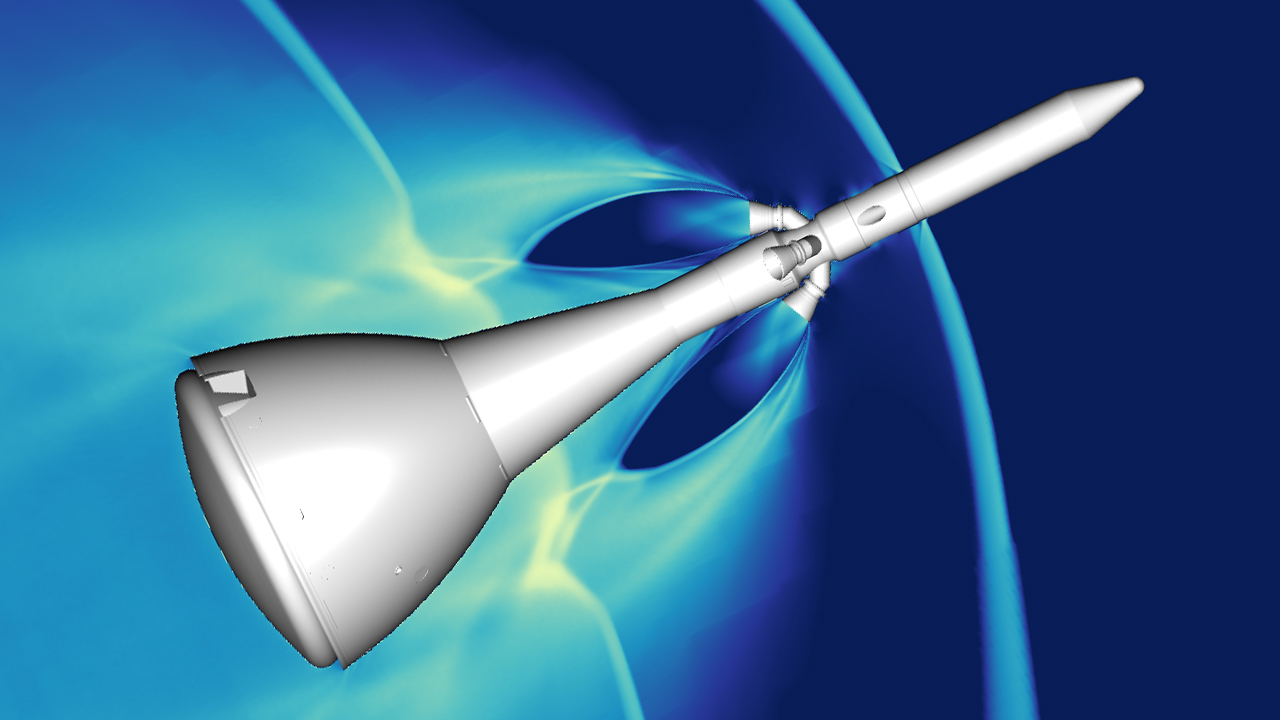
This image is computed using 5,000 snapshots from the longest LAS simulation yet and is rendered by the visualization experts in the NASA Advanced Supercomputing Division at NASA Ames. It provides an in-depth look at the predicted average fluctuations in pressure that cause vibrations on the spacecraft.
High levels of vibration are shown in white; low levels are in blue. A light blue arc upstream from the abort motor nozzles shows a shock wave created by the vehicle’s abort motor nozzles and exhaust plumes when the vehicle travels faster than the speed of sound. The white curves downstream of the nozzles are due to interactions between another shock and the plumes.
To better understand the effects of altitude and velocity on the strength and distribution of these vibrations, a team at Ames produced multiple simulations across a wide range of launch abort scenarios using NASA’s supercomputing resources. They are working to simulate the full-stress test of the LAS, called the Ascent Abort-2 flight test, which NASA successfully completed in 2019. Using cutting-edge Ames-developed software, engineers validated the accuracy of predictions with actual flight test data. In collaboration with the Orion Loads and Dynamics team at NASA’s Johnson Space Center in Houston, the predictions will be used to augment wind-tunnel, ground-test, and flight-test data to help reduce uncertainty of the vibrations on the spacecraft, and ultimately enhance the safety of astronauts during a potential launch abort.
NASA Supercomputers Visualize Quieter Supersonic Flight
by Gianine Figliozzi
NASA’s X-59 Quiet SuperSonic Technology X-plane is designed to fly faster than the speed of sound without producing sonic booms – loud, startling noises which can be disruptive to humans and animals. Currently, commercial aircraft aren’t allowed to fly faster than the speed of sound over land because of the objectionable sonic booms they cause for those on the ground. This experimental plane will fly at a cruise speed roughly double that of a commercial jet while keeping aircraft noise down to a quiet “sonic thump” – or even no sound at all – as heard on the ground when the plane flies overhead at supersonic speeds.
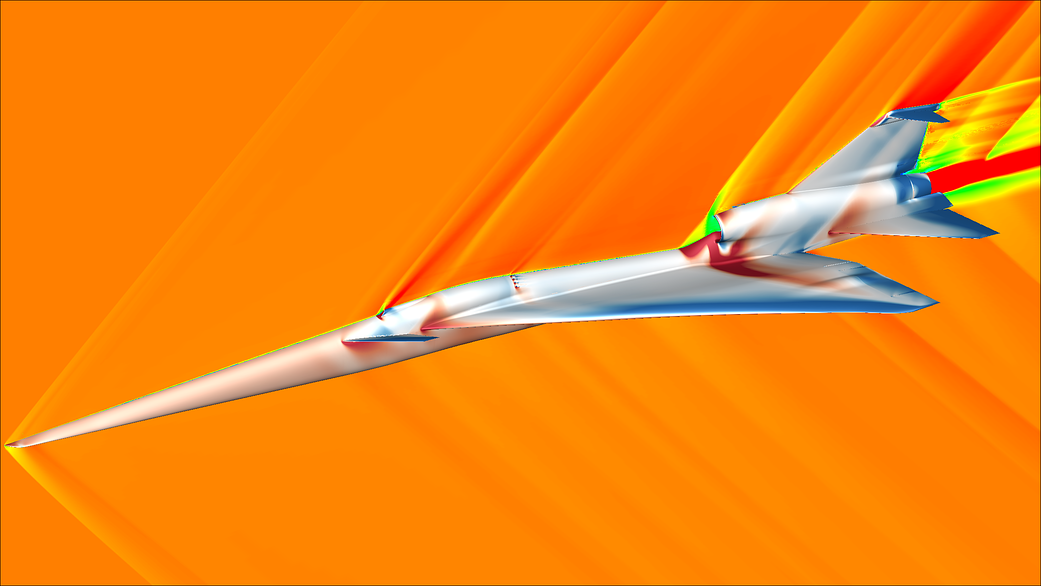
To be sure the X-59’s design will perform within expected noise limits, NASA is working closely with its contractor, Lockheed Martin, to create a large database of computational fluid dynamics simulations to verify the aircraft’s supersonic performance. The database will include simulations for all possible combinations of the settings that a pilot uses to control the aircraft and the flight conditions that may be encountered during flight.
The X-59 is under assembly and will eventually fly piloted test flights over several U.S. cities. NASA’s simulation database will supply inputs for a flight planning tool that will be used to assist the pilot with determining optimum aircraft flight conditions during the flight tests.
Since no experimental data of the X-59 is yet available, it has been crucial to verify results from computational fluid dynamics simulations across multiple software codes to build confidence in the predictions for supersonic performance. Teams at NASA’s Ames Research Center in California’s Silicon Valley and NASA’s Langley Research Center in Hampton, Virginia, worked together to ensure that multiple software codes used in this project predict similar loudness values for the X-59.
This image captures a moment from a computational fluid dynamics simulation of the X-59 aircraft concept during supersonic flight. Visualizations like this help researchers determine which surface features of the aircraft are generating shockwaves, which contribute to the sonic boom noise below the aircraft. The colors shown on the aircraft indicate surface pressure, with lower pressures in blue and higher pressures in red. The colors shown in the airspace surrounding the aircraft indicate airflow velocity, ranging from blue, indicating zero velocity to higher velocities in red. All X-59 simulations completed by the Ames team have been performed on the Pleiades supercomputer at the NASA Advanced Supercomputing facility.
NASA is showcasing 35 of the agency’s exciting computational achievements in its research exhibit at SC20, the international supercomputing conference, Nov. 17-19, 2020. The conference is virtual this year. For more technical information, visit: www.nas.nasa.gov/SC20
NASA’s Using Augmented Reality to Transform Air Traffic Management
by Frank Tavares
If you’re an avid smartphone user, you’ve probably encountered augmented reality before. Whether it’s a filter to give yourself cat ears and whiskers, or collecting creatures that appear in the real world through a videogame, these technologies that create digital overlays on top of the physical world are increasingly becoming a part of our lives.
NASA is using the same technologies to make useful information about all kinds of vehicles in our skies, like drones, more widely available to those who need it. Whether for emergency response, managing air traffic, or local governance, visualizing complex data through augmented reality makes it easier for people on the ground to be aware of the operations of the uncrewed vehicles that will increasingly populate our skies.
NASA researchers using augmented reality technology to test uncrewed vehicle air traffic management software during NASA’s fourth and final Technical Capability Level demonstration of the Unmanned Aircraft Systems Traffic Management project.Credits: NASA/Ames Research Center
“When you see vehicles like drones a few hundred feet above your head, you’re a lot more curious about what’s going on than with a plane that’s several thousands of feet in the sky,” said Joey Mercer, a researcher at NASA Ames. “We wanted to make some of the invisible information about the automated traffic systems managing these vehicles, and the vehicles themselves, more easily accessible from the ground.”
The software to make this happen was developed at the Airspace Operations Laboratory at Ames. It creates a digital overlay with information about flight patterns, a vehicle’s mission, and more – essential information as such vehicles become integrated into our day to day lives. Airspace operators, local public officials, emergency responders, and more may have needs for awareness of what’s happening in their local airspace. As more unconventional aircraft integrate into these environments, it’s important for them to do so safely and with appropriate communications to local communities. The software leverages the capabilities of a commonly available mixed-reality headset, Microsoft HoloLens, to visualize this data in the real world. By naturally swiping and selecting items through hand gestures and eye-tracking technology, NASA is helping air traffic management happen in a far more interactive way than it has previously.
The headsets are very useful for certain scenarios, but to make information even more accessible, this augmented reality software can also be used on smartphone devices. In the future, when you see someone with their phone out and pointed towards the sky while walking down the street, they may be looking at data related to a drone flying overhead instead of taking a selfie.
Augmented reality contributes to NASA’s future in Advanced Air Mobility, or AAM, which aims to develop air transportation systems that move people and cargo between places previous not served or underserved by aviation. New technologies help address the unique challenges that come with drones and other uncrewed vehicles, where vehicles don’t necessarily have a set flight path or trajectory like larger aircraft, and are also more visible to the ground-based public. For smaller uncrewed aircraft in urban environments, augmented reality allows researchers on the ground to help test air traffic management systems by overlaying real-world environments with interactive data visualizations, including other simulated aircraft.
This technology underwent a field evaluation during NASA’s fourth and final Technical Capability Level demonstration, or TCL4, of the Unmanned Aircraft Systems Traffic Management, or UTM, project. Researchers used HoloLens devices to run the prototype augmented reality software to track the drones participating in the demonstration in real-time, visualizing data gathered and spatial relationships between multiple flight paths and objects in the real world. The software can also be used to visualize simulated drones in the same airspace.
“Uncrewed aircraft are more and more becoming a part of our lives,” said Mercer. “As we look at how to safely integrate these vehicles into already complex city infrastructures and airspaces, augmented reality is a great tool, with a lot of potential for how we think of managing our skies in the future.”

